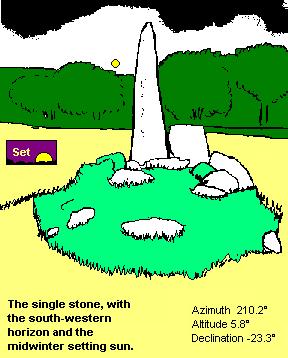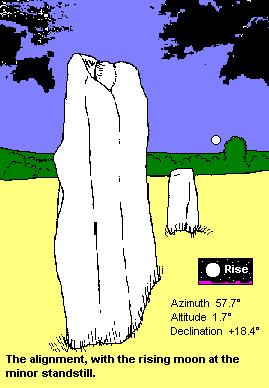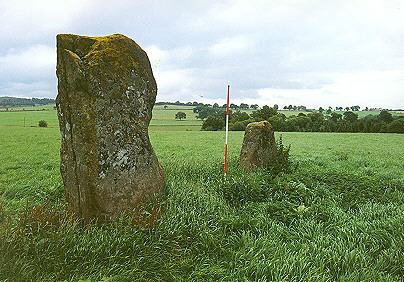
Dalchirla, Perthshire - standing stones
Stones
of Wonder
QUICK LINKS ...
HOME PAGE
INTRODUCTION
WATCHING
THE SUN, MOON AND STARS
THE
MONUMENTS
THE
PEOPLE AND THE SKY
BACKGROUND
ARCHAEOASTRONOMY
USING
THE SITE DESCRIPTION PAGES
VISITING
THE SITES
THE
LEY LINE MYSTERY
THE
SITES
ARGYLL
AND ARRAN
MID
AND SOUTH SCOTLAND
NORTH
AND NORTH-EAST SCOTLAND
WESTERN
ISLES AND MULL
Data
DATES
OF EQUINOXES AND SOLSTICES, 1997 to 2030 AD
DATES
OF MIDSUMMER AND MIDWINTER FULL MOONS, 1997 to 2030 AD
POSTSCRIPT
Individual
Site References
Bibliography
Links
to other relevant pages
Contact
me at : rpollock456@gmail.com
Standing stones NN824159* & NN823162*
 How
to find: The
site is off a minor road which runs between Muthill and the B827. From
the Muthill (east) side take the A822 north for a few hundred metres,
then turn left onto the minor road signposted Golf Course / Blairinroar.
Follow this road west for 4 km, when you will see Dalchirla farm and the
stones on the flat ground to the south. It is a walk of about a kilometre
to the stones, or you may wish to drive to the farm and ask permission
to park and visit the stones, but the farm track down is a bit rough.
How
to find: The
site is off a minor road which runs between Muthill and the B827. From
the Muthill (east) side take the A822 north for a few hundred metres,
then turn left onto the minor road signposted Golf Course / Blairinroar.
Follow this road west for 4 km, when you will see Dalchirla farm and the
stones on the flat ground to the south. It is a walk of about a kilometre
to the stones, or you may wish to drive to the farm and ask permission
to park and visit the stones, but the farm track down is a bit rough.
Approaching from the west side, the B827 Braco-Dalginross road, look for the minor road signposted 'Muthill' and follow it for 5km to the farm. The site is also known as 'Muthill'.
Best time of year to visit: Lunar minor standstill ; winter solstice sunset.
There are two standing stone sites beside Dalchirla farm. On the east side of the track to the farm there is an alignment of two stones, with another fragment between. On the west side of the track is another standing stone, surrounded by a pile of field clearance.
 To take the two stone alignment first, the stones are set in a north-east
to south-west line. There are a few faint cupmarks on the eastern side
of the larger stone. To the south-west the azimuth of 237.7° with
a horizon height of about 5° yields no astronomical line. To the north-east
however the azimuth of 57.7° with a horizon altitude of 1.7° gives
a declination of +18.4°, which is good for the rising moon at the
minor standstill.
To take the two stone alignment first, the stones are set in a north-east
to south-west line. There are a few faint cupmarks on the eastern side
of the larger stone. To the south-west the azimuth of 237.7° with
a horizon height of about 5° yields no astronomical line. To the north-east
however the azimuth of 57.7° with a horizon altitude of 1.7° gives
a declination of +18.4°, which is good for the rising moon at the
minor standstill.
The single standing stone has flat faces which indicate high ridges to both the north-east and the south-west. To the north-east the bearing of 30.2° with a horizon height of 3° gives a declination beyond that ever reached by the sun or the moon. To the south-west the azimuth of 210.2° with a high horizon of 5.8° produces a declination of -23.3°, and the stone may have been intended to mark the position of the setting sun at midwinter.

Dalchirla alignment
Return
to Mid and South Scotland index